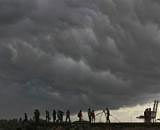
No other weather phenomenon, perhaps, captures the attention of Indians as does monsoon, a shortfall of which can not just send the economy reeling, and people sweating, but also alter the fortunes of governments in power.
Why is monsoon -- more importantly, the south-west monsoon rains -- so important for India, and why is the country so dependent on it even after it is well into the 65th year of its independence?
For one, this annual weather phenomenon accounts for as much as 75 percent of India's rains and over a half of the agriculture sector's water needs. It is also singularly responsible for refilling the reservoirs, so crucial for our daily dose of water.
"All of us are 'Chasing the Monsoon'," Reserve Bank of India (RBI) Governor D. Subbarao had said in one of his lectures, emphasising on the importance of these rains that come between June and October, drawing from Alexander Frater's book by the same name.
"Right when I started my career, monsoon had an impact on my emotional well-being, on my career prospects," said Subbarao, who topped the 1972 batch of the Indian Administrative Service and opted for Andhra Pradesh cadre.
"If it rains, everything is well on earth and cordial in heaven. You carry on with your work. But if it doesn't, all you did was drought-relief. Now at the end of my career, I realise I am once again hostage to monsoon," he said.
"If it rains, the monetary policy works. Everything is all right. If it doesn't rain, there is worry," the central bank governor said, adding: "So I want you to realise that all of us are 'chasing the monsoon'."
Subbarao used the phrase from Fraters' book that illustrates the author's experiences of a journey that begins at Thirunananthapuram June 1, when the first monsoon showers arrive on India's mainland.
He is then in Kovalam, watching children rejoice with the first showers, moves northward via Kochi and Goa to Delhi and even the northeast, learning on the way how these annual rains drive the lives of an Indian farmer, policy-makers and the city-dweller alike.
Such is the grip monsoon has on the India psyche that Pranab Mukherjee, the presidential candidate of the United Progressive Alliance (UPA), had termed the monsoon as the "real finance minister" of the country.
To give some statistics, India receives annual rainfall of around 4,000 billion cubic metres, of which three-fourths comes during the four-and-a-half months of south-west monsoon. Of this, only 1,100 billion cubic metres is utilised. The rest flows away.
If nature refuses to shower her benevolence any year, farmers go without water for their crops, rural folk have to walk miles to quench their thirst, urban street dwellers die of sun stroke -- in fact, the economy as a whole suffers and prices shoot up.
Experts maintain this rainfall can and must be harnessed. One such proposal is for the inter-linking of rivers from the abundant north to the scarcity-hit west and the south -- a pet project that was pushed hard by former president A.P.J. Abdul Kalam.
The estimated cost of $125 billion appears daunting but such schemes have been executed in the US, Russia and China.
There are other proposals as well like creating perennial water bodies, rain harvesting and conservation, re-forestation and percolation projects to ensure underground aquifers get refilled. All these, must be collectively and gainfully deployed.
Only then can India step up the area under crops and raise grain output to the desired 380 million tonnes by 2025 from less than 250 million tonnes now. Otherwise, another finance minister will say monsoon and not he/she is real claimant to the portfolio.